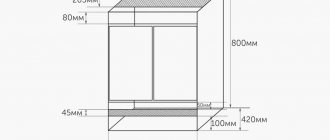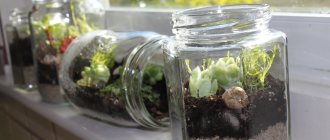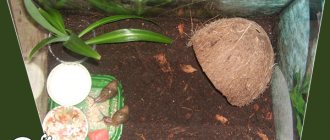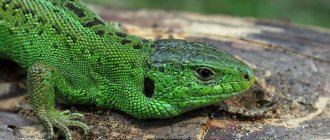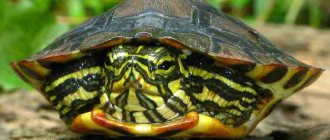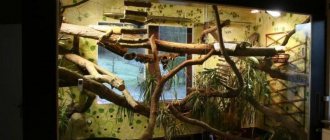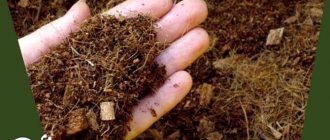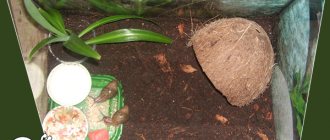A terrarium is a container in which small flightless terrestrial animals are kept ( terra in Latin means “earth” ).
Terrariums are set up for interior decoration, observing animals for scientific and educational purposes, arranging exhibitions, etc. Typically, a terrarium has the form of a mesh box with a glazed front wall.
Why do you need a terrarium for snakes?
A terrarium is a home for a snake. Keeping snakes in a terrarium is mandatory. The snake cannot move freely around the rooms, even if there is no carpet on the floor and there are no dangerous things in the room. For a snake, a terrarium is a resting place and a safe haven. Snakes tend to seek out secluded areas that are not too large in size. The terrarium is the only place where snakes are kept. The terrarium protects the snake from stress; it feels safe in it. It is for this purpose that the terrarium is equipped with a shelter, a house for the snake. The terrarium is designed so that the home is as similar as possible to the natural habitats of snakes.
A terrarium for a snake has more constant lighting than in an apartment, which also protects the snake from stress. In the terrarium, the snake eats food and drinks water. The terrarium protects the snake from people, which will allow you not to be afraid of accidentally bumping into it or stepping on it.
Equipment and design of the terrarium
Purchasing an aquarium does not mean that everything is completed. It is also important to equip it correctly so that the snake feels as comfortable as possible.
Heating
The most important thing for snakes is warmth, as they are cold-blooded. That is why you need to give preference to thermal mats and thermal cords.
For heating, you should give preference to thermal mats and thermal cords
It is better to equip two zones, one of which will be warm (the temperature will range from 29-35 degrees Celsius), and the other corner will be cool (the temperature will range from 23 to 27 degrees Celsius).
It is important to ensure that the heater is on 12 hours a day. Snakes are used to cold nights, but cold days are dangerous for them.
Lighting
Snakes are accustomed to 12-hour daylight hours. The lighting should be bright, but not so strong that it heats up the aquarium. You need to think about this in advance.
It is recommended to place such a terrarium either on a window where there is no too bright direct sunlight. Or you will have to buy special fluorescent lighting in the form of lamps, but install it in such a way that the light is not too low.
After the day, it is recommended to turn off the lights, as snakes need rest and a full night.
The lighting should be bright, but not strong, so as not to heat the aquarium
Drinking bowl
You need to install a drinking bowl in the terrarium. Snakes, like other animals, need moisture. Make sure the drinking bowl is clean. It is recommended to change the water in it 2 to 3 times a week. The size of the drinker should accommodate the daily amount of water (up to 100 ml).
The drinking bowl should not only provide a source of water, but also maintain humidity inside the tank. You can also create moisture by timely spraying surfaces with a spray bottle.
It is recommended to change the water in the drinking bowl 2 to 3 times a week
Substrate
The snake will feel uncomfortable living on bare glass. That is why it is recommended to think about the substrate. It should be pleasant and comfortable for the snake, and not cause inconvenience to it. Often coconut chips, sawdust and moss are chosen for this. It is important to proceed from what kind of substrate the earth is accustomed to in its actual living conditions.
If the above substrate is not available, you can use paper towels and napkins torn into pieces.
You can also put dry bark on the bottom of the aquarium; snakes respond well to this type of filler in their tank.
Often coconut chips, sawdust or moss are chosen for the substrate.
Plants
Snakes are indifferent to green plants.
If snakes are arboreal, then in order to make them comfortable, it is better to install dry driftwood. In this case, the snake will climb up them and settle where it is convenient for it. If you want to add vegetation to the aquarium, you can purchase special live moss, which is sold in the store. True, it is necessary to clarify whether this moss can be combined with snakes and whether it will be safe for the inhabitants of the terrarium.
driftwood
Driftwood is a mandatory attribute of every terrarium. You can make this decorative element yourself. All you have to do is go to the forest and find an interesting tree with spreading dry branches. It is important to properly disinfect such driftwood. First, you need to wipe it with antiseptic solutions. And then place it in the oven, where at high temperatures it gets rid of pathogenic bacteria.
Driftwood is a mandatory attribute of every terrarium
If you are worried that snags may cause illness in the inhabitants of the terrarium, then it is better to purchase ready-made disinfected products in a special department of pet stores.
Diamond Python ($1500)
0
Source:
These snakes, native to southern Australia, do not like extreme heat and, accordingly, are not as picky about indoor temperature as their relatives. They say that the genetic changes that cause the snake's skin to acquire such an unusual color also give it problems with bone development. And in general, according to experts, diamond pythons are not distinguished by excellent health. But a responsible breeder who knows his snakes will never offer the buyer a sick animal, offering to choose from those who are healthier.
“Who, who lives in the little house?”
Terrariums most often contain:
– invertebrates – mollusks, insects, centipedes, spiders, scorpions;
– amphibians – frogs, toads, salamanders, newts;
– reptiles – lizards, geckos, snakes, chameleons, turtles, crocodiles.
Sometimes mammals are also placed in the terrarium. However, aviaries and cages are more suitable for them, since even small animals are very active.
The first terrariums appeared when exotic inhabitants of distant countries began to be brought to Europe. In order for the animals to survive the road safely, it was necessary to create suitable conditions for them on the caravels. Modern terrariums also require a lot of care - about temperature, lighting, air humidity, soil, and creating a familiar environment for the wards.
Climbing animals need vines, branches, snags, while those who like damp shelters need moss and stones.
Arrangement
Having made the basic structure, you can begin arranging a new home for animals. Sand is usually used as soil. It should be small, clean, free of any debris and dust. If there is stone fines, it needs to be sifted and large stones placed on the surface. The loose sand needs to be changed every 5-6 months. The newly laid sand should not differ from the previous one in either humidity or temperature.
Water is an indispensable element of the ecosystem, even for representatives of desert fauna. It can be located in a decorative pond made of glass, earthenware, plastic and other materials. The option of installing a natural reservoir in the corner is also convenient. To do this, the structure must have a slight slope. It is necessary to take into account the need for water of different species of fauna. For amphibians, its constant presence is mandatory: the slightest interruption in moisture, dry air or soil leads to their death.
Reptiles need water only for drinking. A container of water for lizards should be dug into the ground: under natural conditions, they look for moisture below. If the edge of the container protrudes above the surface, reptiles may not find water. Certain species of desert lizards do not drink from standing water. To give them water, you need to spray plants and stones. Reptiles will lick the droplets of water.
For snakes, turtles and some amphibians, water is of paramount importance. From the secretions of these inhabitants and from the remains of food, which they often take directly in the water, the latter loses its transparency. It turns brown and starts making noises.
The difference between an aquarium and a terrarium
These include:
- Purpose. An aquarium is an aquatic environment, while a terrarium is an terrestrial environment (for example, with fillers such as soil and sand, rather than water).
- Inhabitants: in the first - aquatic animals, in the second - terrestrial and reptiles (for example, snakes).
- Different material densities: Aquariums have thicker walls to support the weight and pressure of the water.
- The presence of a special lid in the front of the container: terrariums have it, aquariums do not.
- Possibility of location in the sun: aquariums should not be placed in open areas, because this can provoke the growth of algae, but for terrariums this is most often beneficial.
Requirements for the care and conditions of keeping kalamoichta
The aquarium must be tightly closed! If there are any gaps for tubes and wires, it is better to plug them with a sponge. Kalamoicht can get out into the wild in a matter of seconds, but it cannot exist without water for long. This is very important, guys and girls! Do not neglect this rule. Or one fine day, you will find a snake-like ram near the aquarium.
Pisces are not capricious when it comes to lighting; it can be anything. At the same time, fish like to climb onto the filter and bask under the light bulb, so at least some lighting is necessary. For the most part, this is a twilight resident, the peak of activity is observed in dim light.
Kalamoicht photo
They love clean water, so filtration is mandatory. Aeration is not necessary, since this type of fish breathes atmospheric air. But nevertheless, oxygen is necessary for beneficial nitrifying bacteria, otherwise an outbreak of nitrogenous compounds will occur. As with any other fish, high concentrations of poisons are unacceptable: ammonia, nitrites and nitrates . Every conscientious aquarist should always have a set of drop tests on hand, at least for nitrate and phosphate. Fortunately, they have now become inexpensive, there are no problems with their assortment and acquisition. For example, we can with a clear conscience recommend you the cool UHE drop tests, , but they are sold only online. In stores in your city - offline, you can find inexpensive Vladox tests .
In their natural habitat, calamoikhtas live in small river backwaters or lake lagoons, where there is quite rich and varied underwater vegetation. From this we can assume that the presence of plants in the aquarium is necessary, and those in which you can hide. In addition to plants, the aquarium should be equipped with decor for shelter (pots, amphorae, shells, stones, driftwood). As a rule, kalamoichts are not very secretive fish; they like to sit by the glass, “observing the situation,” but they live long, calmly and happily, only knowing for sure that in case of danger they have somewhere to hide.
How much does it cost to keep a snake?
When taking your pet home, you need to consider the cost of keeping it. This includes one-time costs incurred at the beginning: construction or purchase of the terrarium, equipment and purchase of the animal itself. Other regular expenses are:
- Food
- Bed dress
- Replacing accessories
- As well as electricity costs (snakes require heating and lighting of the terrarium). Since each species has its own preferences, we must check the ideal temperature for our pet, as well as the timing and type of exposure, before purchasing.
Not only "terra"
Crabs, most amphibians, and some turtles need a body of water, at least a tiny one, for normal existence. By arranging it, you turn their home into an aquaterrarium . If the micropond near the front glass takes up no less space than land with plants and animals, then we have a paludarium (Latin palus - “swamp” ). Maintaining it in decent shape is a troublesome task, and museums and zoos usually do this.
Another option is an all-glass container in which only plants live. Plus soil, some nice rocks, a shell. This florarium is placed on a shelf, a table, mounted on a wall, or hung in a window opening. Maintenance of the composition is minimal, the benefits are undeniable: it pleases the eye, soothes, and moisturizes the too dry air of the apartment.
Forms of terrariums [edit | edit code]
The shape of terrariums is also different and depends on what animals are kept in them. According to their form they can be divided into:
Horizontal
- a terrarium whose length is two or more times its height, and its width is about one and a half times its height. Designed for keeping terrestrial animals that do not climb trees or vertical surfaces: many snakes and lizards, toads, land turtles and many other animals.
Vertical
- a terrarium, the height of which is two or more times greater than its length, and the width can be approximately equal to the length. In such a terrarium, strong tree branches or driftwood, vines are installed, and the back wall is sometimes decorated with bark, cork, stone or ceramic tiles, which allows animals to climb. Used to keep animals such as chameleons, many geckos, green iguanas, tree snakes, tree frogs and other tree frogs.
Cubic
- intermediate type. The length, width and height of such a terrarium are approximately equal. Used for keeping animals that equally use both vertical and horizontal surfaces. By creating a thick layer of soil in a cubic terrarium, it can be used to contain burrowing species (for example, spadefoots and some skinks).
Breeding and sexual characteristics of the Calabar calamoikhta
Sexual differences between males and females can be seen if you look closely at them =). The female has a slightly drooping abdomen and the anal fin is much lighter than that of the males. As a rule, it has a yellowish-olive tint. Also, males have from 12 to 14 dorsal fins, while females have from 9 to 12. The Calabar kalamoichta has no other distinctive sexual characteristics.
Without artificial hormonal stimulation, calamoikhtas do not reproduce outside natural conditions. Over many, many years, very few people have been able to achieve concrete success in breeding them. Therefore, little is known about the “caviar-fish” episode. Already grown kalamoikhts are brought directly from the nooks and crannies of their vast homeland.
Interesting things about the snake
Near the reservoirs of West Africa, where our Calabar calamoikht settled, legends were made about the strange snake fish. And they were always not to the advantage of the fish themselves.
Being a snake fish in Nigeria is the same as being a black cat in Russia. Kalamaicht was always killed, mistaking him for something other than who he really was. From afar, the kalamoichta, which, of course, is not surprising, was often mistaken for simply a snake. And in those places, how sad it is, almost all snakes are poisonous and bring a lot of trouble to local residents.
Over time, the kalamoichta was nevertheless separated from the species of snakes. But the next sentence for him was still disappointing. Superstitious residents, having heard enough fairy tales and legends from traders from the river, could not help but notice some similarities between the kalamoicht and the Chinese serpentine dragon, which punished the unfaithful and wicked, was wise, but impatient.
Without hesitation, the local aborigines came to the conclusion that the Gods were angry with the people of Nigeria and, having pierced the earth, opened a gap in the river into the very heat of the earth, from where justice emerges in the form of Kalamaichts. Nigerians had much to fear. At that time, they sold everything they could. It was then that the trade in gold and diamonds flourished. And their Gods forbade trading in their homeland. Frightened people were just waiting for a reason to see the personification of punishment for their sins. And according to the description of the merchant-storytellers, the Punisher Serpent is, well, a perfect kalamoicht. A long body, wings growing from the head, spikes on the back and tail, lives in water, and is born there from the bowels of the earth.
Mistaking adult, almost meter-long kalamoichts for newborn Snake-Dragons, people have ruined a simply monstrous number of these lovely creatures. There were even special hunters who protected their villages from the Wise Snake.
And yet, one of the oldest fish on our planet, having been both a snake and a dragon, has lived to this day to become an aquarium pet and delight the eye with its grace, agility and unusualness.
Feeding
Another important aspect of keeping snakes is feeding. Almost all snakes kept in captivity are carnivorous predators and eat rodents, birds, other reptiles or amphibians. The vast majority in captivity feed on rodents and birds. Snakes do not eat dumplings, raw meat or chicken legs. Don't listen to people who say otherwise! A piece of raw meat does not contain such a variety of vitamins, minerals, and nutrients as in a full-fledged food item (FO). The snake takes vitamins from meat, wool, bones, feathers, and internal organs.
One of the main rules is not to overfeed. Moreover, it is better to underfeed than to overfeed. If you feed too often, the snake may become obese - this is very dangerous for the snake's life. The likelihood of KO regurgitation also increases. So, let's decide on the frequency of feeding. Young animals up to six months or a year are fed approximately once a week, gradually increasing the intervals between meals. Adult snakes are fed approximately once every 10-20 days, and if they are large snakes (boas, pythons) they can be fed once every 30-40 days. All these recommendations are approximate, so you yourself will have to adjust the snake’s feeding regimen. The main thing is that the snake does not grow in width) A few words about the size of the KO. Again, the recommendations are quite rough. As a guide, the thickness of the KO should be approximately equal to the thickest part of the snake. If possible, it is worthwhile to diversify your pet's food - poultry contains vitamins that are not found in rats and mice. Another important note: you should not feed hamsters. Hamsters are a treat for any snake, but they are very fatty - the conclusion is clear, use only if the snake does not eat anything else. I also note that one-day-old chicks/chicks should have their yolk sac removed. The yolk is poorly digested in the snake's body. Another important note: do not handle the snake after you have fed it for at least a few days. Small ones - at least three days, large ones - 5-7 days. Also, do not feed snakes while they are molting.
What a beginner needs to know about keeping snakes
Now in Tver you can watch the show “House of Reptiles and Monkeys”, where many poisonous snakes, boa constrictors, and anacondas are presented. Unfortunately, located not far from the visiting exhibition, the Tver terrarium now cannot boast of a variety of inhabitants.
So there is a desire among pet lovers to adopt a snake as a pet. But before you look for advertisements for sale and buy a one and a half month old baby snake or boa constrictor, you need to prepare a place for keeping the cold-blooded one and get acquainted with the basic knowledge of caring for reptiles.
Wasaj and SS, www.myreptile.ru: “The fundamental principles of arranging a terrarium for any snake can be formulated with the phrases “the most important thing is the ability to choose” and “the simpler the better.” The first statement means that it is necessary to create areas in the terrarium with different values of each of the key abiotic parameters of the habitat (primarily temperature and humidity), and the second - that of all the available methods of providing for one or another need of the snake, one should choose the technically simplest and most reliable.
Size and type of terrarium
Regardless of what lifestyle the snake leads, the size of the terrarium should correspond to its size. You should not put a young snake immediately in a large terrarium designed for its adult size - this makes it very difficult to observe it, since a small animal in a large volume is constantly trying to hide. The absence of such an opportunity will most likely lead to stress, refusal of food, impaired growth and, in the long term, to illness and death. Therefore, it is much better to transfer the snake to larger containers as it grows, and start with the minimum required size.
A completely logical question arises: what are these “minimum required sizes”? The answer lies in the peculiarities of thermoregulation of reptiles as poikilothermic animals - the minimum acceptable size of the terrarium is one that allows you to create the necessary temperature difference between the “warming point” and the “cold corner” and gives the snake the opportunity to move freely between them, choosing the temperature it needs at the moment. This means that the size of the terrarium should allow the snake, curled up in a spiral or ball, to be completely located in that part of the terrarium where the temperature it needs at the moment is. The proportions of the length, width and height of the terrarium (i.e. its type - horizontal, vertical, cubic) are determined by the lifestyle of the snake: for terrestrial species, the area is primarily important, for arboreal species - the height. The required temperature difference in the first case is created horizontally, in the second - vertically, branches, shelves or any crossbars are placed at different distances from the local heat source, on which the snake can be completely accommodated.
Let us explain this with specific examples from practice:
- For a corn snake (ground snake) with a body length of 30-45 cm, a container with a bottom area of 20-30x15-20 cm is sufficient. The height can be from 10 cm. A container of this size allows you to create an area of approximately 4-7x15 cm on one of its smaller sides. 20 cm with a temperature of 29-31°C, at the opposite edge of the container the temperature will be approximately equal to room temperature or slightly higher (23-25°C). When a snake of the named length curls up, it can completely position itself in any of the temperature zones existing in the terrarium, etc. this area can be considered sufficient.
- For a royal python (land snake) 70-110 cm long, a container with a bottom area of 60-70x35-45 cm and a height of 15 cm is sufficient. In this container, you can make an area with a temperature of 30-35 ° C along one of the smaller sides, measuring 15- 20x35-45 cm. Then at its opposite edge the temperature, as in the previous example, will differ slightly from room temperature. The areas of the heated and “cold” zones allow a snake of this size to fully accommodate itself in the temperature conditions that it needs at the moment.
- For a garden boa (tree snake) about 1 m long, a container with a height of 50-70 cm and a base side of 25-35 cm is sufficient. An incandescent lamp with a power of 15-25 W is placed under the ceiling in one of the corners of the terrarium, under it at a distance of 12-15 cm you need to place a horizontally oriented crossbar (branch, plastic tube) or shelf. The remaining crossbars are placed lower at the same interval from each other. The snake can completely settle down on any of them and thereby warm up or cool down according to its needs.
The extremely important requirements for the design of any terrarium for a snake are the tightness of its assembly and the reliability of the locks. Snakes, like no other reptiles, are able to crawl into the smallest cracks and holes. Therefore, all the seams of the terrarium should be as tight as possible (ideally, completely sealed), and the doors or lid should fit tightly to the wall surfaces joining them and be closed with latches that prevent self-opening. All these requirements are fully met by plastic food containers with latched handles. They should be recognized as the simplest and most reliable option for a terrarium for snakes available today.
Organization of local heating, ensuring the necessary temperature gradient and its daily fluctuations
Since snakes are poikilothermic animals, they regulate their temperature through behavioral reactions, moving between more or less warm areas. It follows that in order to successfully keep a snake, it is necessary to provide it with the opportunity to warm up to a temperature slightly higher than the optimal one (for each specific species), and then move to a zone with a lower temperature, down to one that is slightly below the optimum. In other words, it is extremely important to give her the opportunity to choose between zones with different temperatures. In practice, compliance with these conditions is achieved by proper organization of the local heating zone.
In accordance with the principle “the simpler the better,” we can recommend two main technical solutions for creating a “warm corner” in a terrarium for a snake - heating with incandescent lamps and heating with thermal mats or thermal cords.
Incandescent bulbs are best suited for heating glass or wood terrariums. It is more convenient to heat plastic terrariums with a thermal cord or thermal mat. The choice of incandescent lamp power is determined by the size of the terrarium, the material from which it is made, the temperature in the room where the terrarium is located, and the required temperature in the local heating zone. Very often questions arise about protecting a snake from possible burns from a lamp. Practice shows that the best protection is provided, oddly enough, by the absence of any caps, shades, etc., enclosing the lamp.
Two practical examples of creating a local heating zone using this method:
- An Algerian snake with a body length of 50 cm is kept in a horizontal terrarium measuring 40x20x20 cm. The temperature in the room throughout the day ranges from 19 to 24°C. The required temperature at the heating point is 30-35°C. Heating is provided by one 15 W incandescent lamp suspended on a wire under the outlet ventilation grille. A ceramic shard is placed under the lamp, the distance between it and the lamp is about 10 cm. A lamp of the specified power warms it up to the required temperature. At the opposite end of the terrarium the temperature does not exceed 26°C.
- A thin-tailed snake with a body length of 165 cm is kept in a horizontal terrarium measuring 110x60x40 cm. The required temperature at the heating point is 30-35°C, the temperature in the room is 19-21°C. Heating is carried out by one 40 W incandescent lamp suspended on a wire under the outlet ventilation grille at a distance of 25 cm from the ground surface. It warms up an area with a diameter of about 35 cm to 32-37°C, in the opposite corner the temperature does not exceed 25°C.
In both examples discussed, snakes live in glass terrariums. As noted above, it is better to heat plastic terrariums using a thermal cord or a thermal mat placed under the bottom of the terrarium. This method is especially convenient for heating a large number of plastic containers placed in a row on a shelf.
A groove is made along its entire long edge, into which the thermal cord is placed; the terrariums are installed across the shelf so that a small section of the bottom is located above the cord along their short side. Temperature regulation in this case is achieved by changing the power of the thermal cord and the number of its turns under the terrarium.
When using thermal mats, they are placed under the terrarium in such a way that a certain section of the bottom is located above the mat, minimally sufficient to accommodate the snake on it during warming up.
The vast majority of snakes require daily temperature variation. This is achieved by simply turning off the heating at night. If in the room where terrariums with snakes are located, the temperature at night drops below the permissible values for this type, it is necessary to provide night heating for the “warm corner” of the terrarium. For this purpose, incandescent lamps are no longer suitable; it is necessary to use a thermal cord or thermal mat.
Ventilation
Ensuring convection mixing of air in the terrarium is closely related to the operation of the heating elements, so it is logical to consider ventilation after discussing heating. Because warm air has a lower density than cold air, it rises. If you place one ventilation grill in the “warm” corner of the terrarium, and the second in the “cold” corner, then during operation of the heating element in the terrarium there will be continuous weak air mixing associated with the outflow of warm air through one grill and the entry of cold air into its place through another. By changing the area of input and output ventilation, you can regulate the rate of air exchange in the terrarium. This in turn allows you to control changes in humidity and, to some extent, temperature. In addition, the ventilation intensity can be reduced, if necessary, by placing the inlet and outlet grilles directly in the local heating zone. This may be necessary when keeping moisture-loving snakes that live in the forest floor, such as rainbow boas.
In the simplest case, if the terrarium is a food-grade plastic container, to ensure ventilation it is enough to drill or burn (with a soldering iron, a burning device, a heated nail) 2-5 rows of holes with a diameter of 2-4 mm in one of the smaller sides at the bottom of the container at a height of 3- 5 cm from the floor and in its lid, again near (along) its smaller edge. In a typical case, the container is placed on a thermal cord or thermal mat, as described above, with the rows of holes in the lid located above the heated area of the bottom, and the ventilation inlet holes (in the wall of the container) are located in the “cold” part of the terrarium.
In larger terrariums, “windows” of metal mesh, household ventilation grilles, or plates of perforated metal or plastic are made of glass, wood or other materials to provide ventilation. The principle of their placement remains the same.
Top ventilation:
Bottom ventilation:
Since the operation of ventilation is directly related to maintaining the level of humidity in the terrarium, it would be logical to move on to considering this parameter.
Drinking water and humidity
The terrarium should have areas that differ significantly in the humidity of the substrate (and therefore the air above it), on each of which the snake can fully accommodate. To comply with this condition, shelters are placed in different parts of the terrarium, in which some hygroscopic material is placed (sphagnum or other moss, peat, leaf litter, etc.) and regularly moistened. Such shelters are called “humidity chambers.” Some shelters are made without such a substrate, “dry”, the humidity in them will be approximately the same as in the main volume of the terrarium. As a rule, humidity chambers are placed near local heating, and “dry” shelters are placed in the “cold” corner of the terrarium. Moving between these shelters, the snake itself will choose the level of humidity that it needs at a given time. If you use sphagnum or other types of mosses as soil in a snake's terrarium, then a horizontal moisture gradient can be created by spraying some areas of the substrate and leaving others dry.
Full regular spraying of the entire volume of the terrarium is needed only when keeping particularly moisture-loving species of snakes or during the molting period of mesophilic species. Such cases require separate consideration and are not within the scope of this article.
High humidity in the local heating zone can be maintained by placing a container of water there. In this case, its dimensions should allow the snake to be placed in a heated area outside the water.
Drinking water is necessary to one degree or another for most species of snakes. Its source can, in principle, be any container made of glass or food-grade plastic; their size depends on the biology of a particular species. Many terrestrial snakes, especially those from arid areas, need a small container for drinking, while semi-aquatic species, especially those that feed in water, need a spacious reservoir in which the snake can completely freely accommodate itself. However, a number of species of snakes living in dry biotopes, for example the Californian king snake, willingly climb into water on occasion, especially during the molting period, so it can be recommended for them to make a drinking bowl of such a size that the snake can fit into it.
Shelters
Shelters are absolutely necessary when keeping the vast majority of snake species. The inability to hide leads to stress, increased aggressiveness of the animal, refusal to feed, and even illness and death. The key requirement for snake shelters is that they should not be spacious. The snake feels safe when its body touches the walls of the shelter. Otherwise, the design and material of the shelters are not of fundamental importance - they can be cardboard, wooden or plastic containers of a suitable size with an entrance that allows the snake to crawl into it with large prey in the stomach, i.e. about 2.5-3 times larger size than the maximum thickness of the snake in its normal state.
For this purpose, you can use pieces of bark, shards of ceramic pots, cardboard egg trays, and for the smallest snakes, folded paper. As mentioned above, some shelters are arranged in the form of “humidity chambers”. The minimum required number of shelters is 2, in the local heating zone and in the opposite corner, but during the adaptation period it is useful to place several additional shelters in different places of the terrarium, which reduces stress and makes it easier for the snake to get used to the new environment.
Many snakes do not need additional shelter if they can burrow into a thick layer of moss or leaf litter. If the biology of a particular species allows it to be kept on such a substrate, there is no need to arrange any additional shelters.
Priming
Practice shows that if all the above conditions are met, most species of snakes can survive without soil. Almost universal substrates suitable for keeping a wide variety of snake species include sphagnum (and other mosses) and newspaper or filter paper and its analogues - napkins, paper towels, etc. The second place in versatility is occupied by wood shavings (hardwood), fallen leaves (especially oak leaves), coconut substrate and crushed bark.
Sand is applicable only in certain cases, when keeping desert species of snakes that in nature live on sand and bury themselves in it. Soil moistening in this case has a number of specific features that are beyond the scope of our article and are described in detail in the book “Terrarium and Its Inhabitants”.
Mosses, especially sphagnum moss, have a number of remarkable features that make them the #1 substrate for snake terrariums. They do not generate dust, allow you to maintain a wide range of humidity and create a horizontal difference, serve as a shelter in themselves, in some cases emit antiseptic substances, absorb the liquid part of feces well and, finally, are decorative.
However, when parasitic mites appear, moss must be abandoned, since it serves as an excellent refuge for them. During this time, animals are kept on paper or without any soil at all.
landscaping
Growing plants in a terrarium is a topic for a separate discussion and is beyond the scope of this article. Here we only note that the presence of living plants in the terrarium is not one of the primary conditions for the successful keeping of snakes, however, landscaping the terrarium significantly increases its decorative effect, has a beneficial effect on the humidity regime and is very important when keeping small tree species of snakes, since it most closely matches their lifestyle in nature.
Ultraviolet irradiation
As practice shows, most species of snakes do not require ultraviolet (UV) rays for normal functioning. The question of the need for UV when keeping a number of species of diurnal snakes is still largely open, since there are examples of their successful keeping and breeding without a UV source. Apparently, this state of affairs is explained by the fact that snakes obtain vitamin D3 primarily from food. This implies the high value of live and natural food animals and the need for as varied a diet as possible for both the snakes themselves and the laboratory animals intended for them to feed. This statement gives us the right to move on to considering the general principles of feeding snakes.
Feeding features of snakes that are important from the point of view of keeping them in captivity
The vast majority of snake species feed exclusively on animal food; only a very few species have recorded rare cases of eating plant food. The vast majority of snakes in nature feed on live prey; cases of eating dead animals are rather exceptions. Snakes, as a rule, feed rarely or even very rarely, but are capable of eating large prey relative to their size in one meal. It is these features that primarily dictate the basic rules for feeding snakes when kept in a terrarium - it is necessary to use natural food as often as possible, the animal’s diet should be as varied as possible, “underfeeding is better than overfeeding.”
If everything is more or less clear with the first two statements, then the last one needs to be specified. As a kind of “golden mean”, suitable in the vast majority of cases, we can take the frequency of feeding once every 7 days with breaks for molting. This is true for young and actively growing snakes, and adults (after the period of rapid growth has ceased), with the exception of females during pregnancy, should be fed once every 10-20 days. Adults of large species of boas and pythons are extremely susceptible to obesity, so it is best to feed them once every 30-40 days. Obesity negatively affects the general condition of the animal, leads to disturbances in reproductive ability, up to its complete loss, and in severe cases can even lead to the death of the snake.
The optimal size of the food object is individual for different species of snakes. As an average value applicable in most cases, we can name the length of the prey equal to two lengths of the snake’s head. The mass of food eaten at one time should be about 20% of the mass of the snake itself. These figures are very approximate and can only be considered a starting point, but not a strict recommendation applicable in all cases. The feeding of different species of snakes or even different individuals of the same species has many features, the consideration of which is no longer within the scope of this article and requires separate discussion in each specific case.
Although many snakes can be switched to eating dead food animals, it is recommended to use live food whenever possible, as it is more complete. In conclusion, we once again consider it necessary to mention the increased value of natural feeds compared to any others; they should be used in the first place.”
If you find an error, please select a piece of text and press Ctrl+Enter.
25
1
How to make a terrarium with your own hands
Making a terrarium with your own hands is a labor-intensive process, but at the same time interesting and exciting. First you need to decide what material the terrarium will be made of.
Silicate or organic glass is more often chosen. Such terrariums are difficult to break, and most importantly, these materials are easy to process.
In addition to the material, you must purchase:
- corners;
- mesh for ventilation;
- plastic profiles;
- adhesive composition;
- sandpaper;
- ruler;
- scotch;
- knife;
- scissors.
Having selected organic glass, you need to choose an adhesive composition for it. It is better to purchase it in specialized stores.
It is important to choose glue that is harmless to human and pet health, given that when heated it can release harmful substances.
It is important to choose glue that is harmless to human and pet health.
One of the options for making a terrarium:
- The glass is cut into several pieces.
- Glue each part together, placing a load on top. This is important so that the parts fit together much more tightly and set faster.
- A mesh is placed on top of the walls for ventilation. You can glue it using special double-sided tape. A small hole is left on one side for easy changing of water and feeding.
- If a ventilation system was previously purchased, it is installed in the terrarium.
- Making a terrarium lid. It can be removable or solid. A board that is the same size as the perimeter of the terrarium is suitable for this.
- If there are dangerous places on the board where you can pick up a splinter, then it is recommended to cover the sides with a special film.
- The inside of the terrarium is disinfected.
- Fill in the selected soil.
- Pre-processed driftwood or store-bought driftwood is installed in the center. Moss is placed. Install drinking bowls with water. If necessary, other decorative options are added.
- A thermal mat is placed under the bottom of the tank. It is placed under one of the halves of the terrarium in such a way as to divide the space into a cold and warm zone. This is necessary so that the snake can choose for itself where it is more comfortable for it to be.
Such a terrarium must be installed in common areas, excluding the bedroom and kitchen. A living room will do. It is important to check the security of the lid so that the pet does not escape.
The terrarium must be installed in public areas
Recommendations for purchase and cost
It is necessary to buy such an exotic pet from a breeder, since only he can clarify all the individual characteristics of the individual. The snake must be born in captivity, then adaptation to other conditions will take place quickly and without problems.
When purchasing an animal you need to pay attention to the following points:
- The weight of the snake should be appropriate for its age, it should be well-fed and have muscle tone.
- There should be no damage, scars or abrasions on the skin.
- It is advisable to experimentally test the predator’s ability to feed itself.
- A young snake with a standard color is $15, an adult is more than $30. Albinos or caramel species are several times more expensive.
- Royal python: female - $200 and above, male - 10% lower.
- Imperial boa - from $100 to $300.
- Rainbow Boa starts at $150 and up.
- Dairy and royal - from $70.
Did you know? Snakes are naturally deaf; their eardrums and middle ear are completely atrophied. They pick up sound vibrations with their belly while moving along the ground.
Temperature
Before you start arranging a home for your pet, you need to study the characteristics and preferences of the reptile. For example, snakes, which naturally live in the subtropics and temperate tropics, feel comfortable if the daytime temperature ranges from 25 to 30 degrees, naturally above zero.
Snakes living in tropical latitudes should live at a temperature of 27-35 degrees, and at night the temperature should drop by 4-5 degrees. In order to maintain this temperature regime at night and during the day, you need to use a thermostat.
For pets who are accustomed to the humid climate of the subtropics, it would be useful to install a hygrometer - a device that monitors the level of humidity.
Florarium [edit | edit code]
Florariums as a type of terrarium are becoming increasingly popular in home gardening. They can be of unusual shape and placed on tables and shelves - as a decorative attribute, as well as on window sills, or hung near windows and under ceilings; attach directly to the inner wall of any room in our apartment or house. Florariums can be different not only in shape and size, but also placed in the form of compositions of several vessels with plants in one place. Such terrariums are made from solid glass and plastic - both by the factory method and with the help of improvised means and utensils: broken incandescent lamps, decorative vases and laboratory flasks or spherical aquariums.
Beneficial effect on humans
An experiment was conducted in England in 2011 (Medical Research Council, 2011). It was aimed at studying the effect of aquariums on humans. According to him, the more the recreated aquatic environment is filled with living beings, the more positively it affects a person, because when observing her, the latter’s pulse decreases,
interest and mood increase. There are different assumptions why an artificially created ecosystem has such an effect on humans. One of them is the biophilia hypothesis. It lies in the fact that over a long period of evolution, people have acquired a craving for all living things.
If you follow this hypothesis, then the aquatic environment of the aquarium, albeit artificially created, is filled with living creatures from the wild.
The water itself and its dimensional swaying have a calming effect on a person (Michigan State University's Amber L. Pearson & Daniel Nutsford, the academic journal Health & Place). Thus, aquariums have a healing effect on people.

